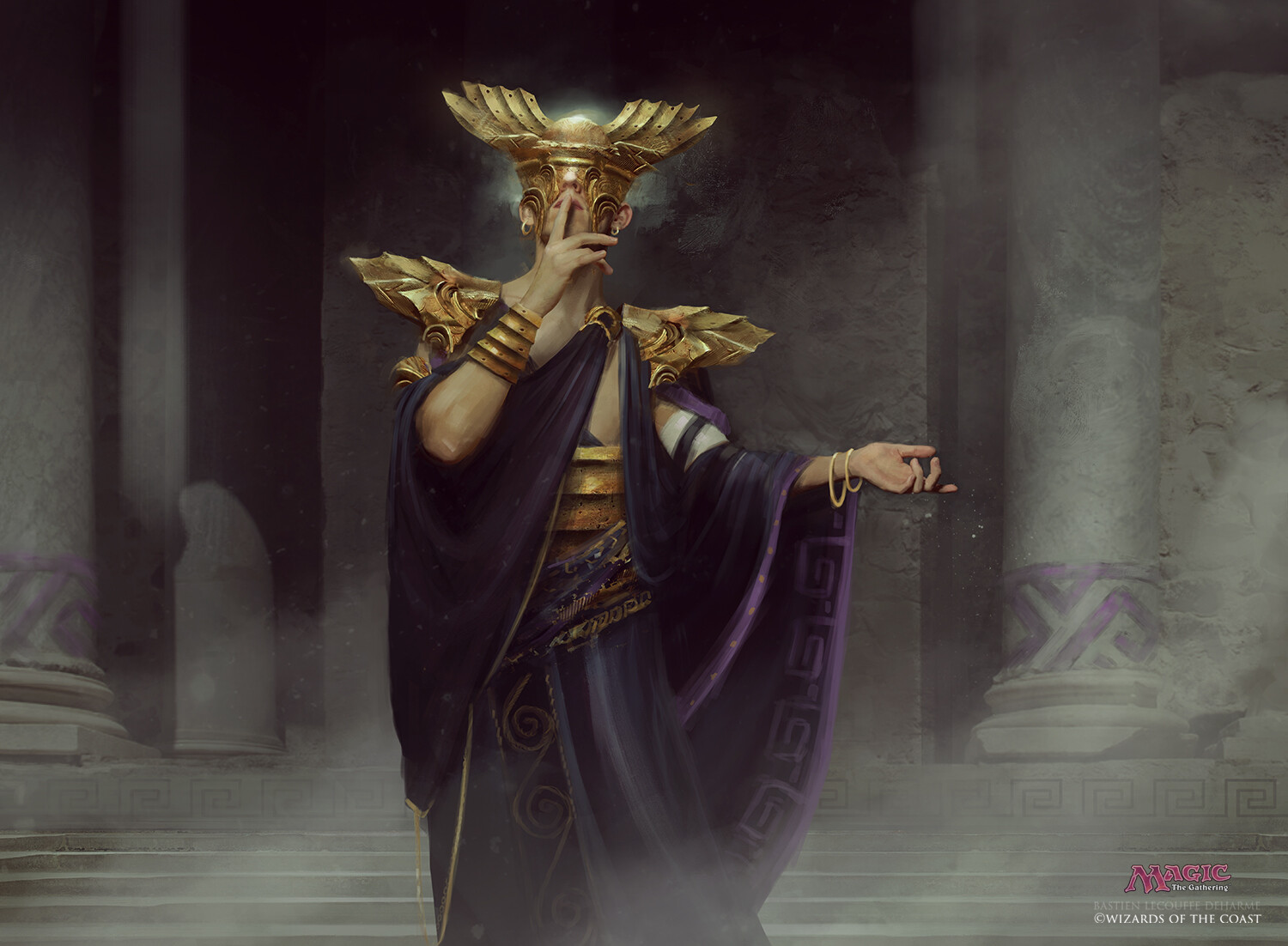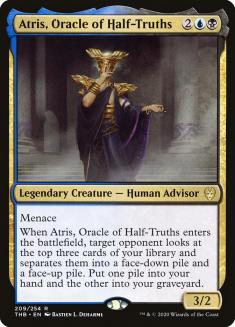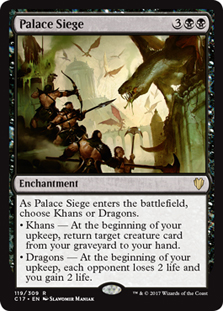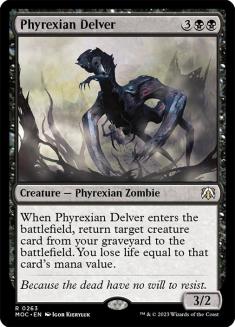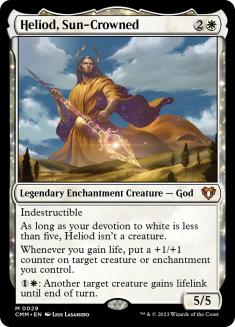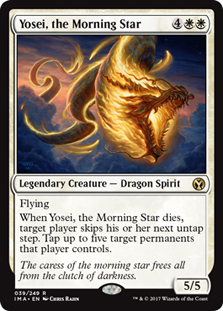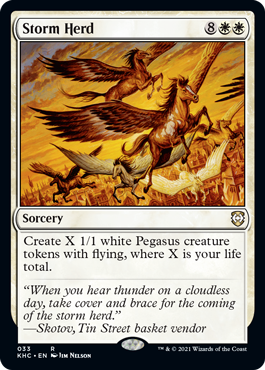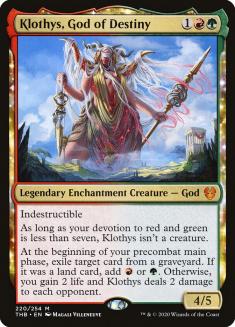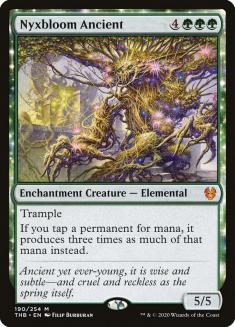I’ve changed up how I’m doing new decks these days. Because there are simply too many great new legends to pick and choose from, I’ve abandoned for now the Do Over Project, in which I put the next 99 with one of my existing commanders. I’m not taking apart the ones I’ve already built, I’m just moving in a new direction for what comes next. My goal is to pick three commanders from each new set and build something novel with them. For the most part, I’m going to do my best to get out of my comfort zone. The good news is that there will be plenty of upcoming commanders to challenge my creativity and innovation.
The three I’ve chosen for Theros Beyond Death are Atris, Oracle of Half-Truths; Heliod, Sun-Crowned; and Klothys, God of Destiny. I had hoped to build Gallia of the Endless Dance, but I really couldn’t find a path to Satyrs that I liked just yet. Getting myself out of a graveyard-recursion comfort zone was something I was going to do with Kunoros, Hound of Athreos, but then I realized that I could cover all five colors by doing Klothys – as well as the fact that I used a few of the lines in Heliod that would be right for Kunoros. I also considered Uro, Titan of Nature’s Wrath, but Game Knights host and Commander Advisory Group member Josh Lee Kwai beat me to the deck I was basically going to build, and no one wants to be a copycat. The good news is that all three of these builds were fun and reminded me of some cards I hadn’t thought about in a while.
Creatures (29)
- 1 Avatar of Woe
- 1 Solemn Simulacrum
- 1 Hell's Caretaker
- 1 Arcanis the Omnipotent
- 1 Phyrexian Delver
- 1 Vexing Sphinx
- 1 Deep-Sea Kraken
- 1 Body Double
- 1 Umbra Stalker
- 1 Sheoldred, Whispering One
- 1 Chancellor of the Spires
- 1 Baleful Strix
- 1 Consuming Aberration
- 1 Sepulchral Primordial
- 1 Abhorrent Overlord
- 1 Thassa, God of the Sea
- 1 Gray Merchant of Asphodel
- 1 Erebos, God of the Dead
- 1 Burnished Hart
- 1 Phenax, God of Deception
- 1 Noxious Gearhulk
- 1 Whisper, Blood Liturgist
- 1 Thief of Sanity
- 1 K'rrik, Son of Yawgmoth
- 1 Syr Konrad, the Grim
- 1 Erebos, Bleak-Hearted
- 1 Devourer of Memory
- 1 Callaphe, Beloved of the Sea
- 1 Thassa's Oracle
Planeswalkers (3)
Lands (37)
Spells (30)
- 1 Mana Vault
- 1 Sol Ring
- 1 Fellwar Stone
- 1 Exhume
- 1 Traumatize
- 1 Future Sight
- 1 Sword of Light and Shadow
- 1 Wayfarer's Bauble
- 1 Aether Snap
- 1 Crystal Shard
- 1 Erratic Portal
- 1 Dawn of the Dead
- 1 Copy Enchantment
- 1 Dimir Signet
- 1 Dread Return
- 1 Makeshift Mannequin
- 1 Memory Plunder
- 1 Repay in Kind
- 1 Exsanguinate
- 1 Command Tower
- 1 Cyclonic Rift
- 1 Dimir Cluestone
- 1 Fated Return
- 1 Extract from Darkness
- 1 Palace Siege
- 1 Phyrexian Scriptures
- 1 Bolas's Citadel
- 1 Arcane Signet
- 1 The Cauldron of Eternity
- 1 Altar of the Pantheon

The primary motivation of the deck is to cast Atris as often as is reasonable without having to pay the commander tax, then use the things that go into the graveyard to fuel your foolishness. There are three sub-themes in the build: self-mill/graveyard reanimation, artifacts, and devotion. You might also consider “life total matters” as a tiny sub-theme.
The self-mill and reanimation is pretty self-explanatory. Atris helps with part of it. I’m a fan of Vexing Sphinx, using its sort of delayed self-mill in order to put the pieces you want into the graveyard while also being able to deliver some beats. Traumatize is another big part; you just have to be prepared for the eventuality that you might really get blown out by Bojuka Bog. Of course, if you have Syr Konrad, the Grim active, that might not be the worst that’ll happen to you. Another thing about graveyard use in Commander is that you need a little less self-mill than you might otherwise. Sweepers happen, meaning you’ve gotten an initial use out of the cards, and then someone else is helping you reuse them. That’s why there are more cards for reanimation, like Palace Siege and Phyrexian Delver.
It occurred to me while I was looking at the devotion cards that there are some artifacts with colored mana in their casting costs, thereby bumping devotion counts. In a two-color deck, in which you need a little less mana smoothing and colorless artifacts, it makes sense to me to go in on artifacts with color, like Baleful Strix, Bolas’s Citadel, and The Cauldron of Eternity. The artifact idea led me to playing Tezzeret the Seeker, both for untapping mana rocks early and searching for cool things late.
Devotion is pretty straightforward. Unlike most decks, in which I feel like I want to limit the number of colored mana symbols, I indulged myself here. Cards that you normally want to tread carefully around in three-color decks, like Arcanis the Omnipotent and Future Sight, became natural fits in a deck like this. Devotion will turn on those Gods, get a bigger drain from Gray Merchant of Asphodel, swing for bigger beats with Callaphe, Beloved of the Sea, and let you look at more cards with Thassa’s Oracle.
There aren’t any combo kills in the deck, but K’rrik, Son of Yawgmoth or Bolas’s Citadel plus Repay in Kind can get you close enough that you don’t have to pump so much mana into Gray Merchant of Asphodel or Exsanguinate to be quite deadly.
Creatures (33)
- 1 Isamaru, Hound of Konda
- 1 Serra Avatar
- 1 Soul Warden
- 1 Yosei, the Morning Star
- 1 Eternal Dragon
- 1 Leonin Shikari
- 1 Michiko Konda, Truth Seeker
- 1 Rune-Tail, Kitsune Ascendant
- 1 Crovax, Ascendant Hero
- 1 Stonecloaker
- 1 Stonehewer Giant
- 1 Knight of the White Orchid
- 1 Felidar Sovereign
- 1 Kor Cartographer
- 1 Stoneforge Mystic
- 1 Linvala, Keeper of Silence
- 1 Serra Ascendant
- 1 Wurmcoil Engine
- 1 Suture Priest
- 1 Grand Abolisher
- 1 Angel of Jubilation
- 1 Rhox Faithmender
- 1 Emeria Shepherd
- 1 Oreskos Explorer
- 1 Stone Haven Outfitter
- 1 Thalia, Heretic Cathar
- 1 Oketra the True
- 1 Balan, Wandering Knight
- 1 Baird, Steward of Argive
- 1 Danitha Capashen, Paragon
- 1 Linden, the Steadfast Queen
- 1 Archon of Absolution
- 1 Daxos, Blessed by the Sun
Planeswalkers (3)
Lands (37)
Spells (26)
- 1 Kismet
- 1 Test of Endurance
- 1 Sword of Fire and Ice
- 1 Mind's Eye
- 1 Crackdown
- 1 Karmic Justice
- 1 Storm Herd
- 1 Return to Dust
- 1 Argentum Armor
- 1 Darksteel Plate
- 1 Faith's Reward
- 1 Rootborn Defenses
- 1 Spear of Heliod
- 1 Godsend
- 1 Comeuppance
- 1 Sword of the Animist
- 1 Make a Stand
- 1 Aetherflux Reservoir
- 1 Hammer of Nazahn
- 1 Ravnica at War
- 1 Single Combat
- 1 Sword of Sinew and Steel
- 1 Mace of the Valiant
- 1 Elspeth Conquers Death
- 1 Shatter the Sky
- 1 Heliod's Intervention

The trick here was to not try to recreate my Heliod, God of the Sun deck, which has a heavy enchantment theme. I also didn’t want to borrow too many tricks from Trostani and Her Angels, which is a lifegain deck. Clearly, some of the latter was going to happen.
The idea of the deck is to provide a low mana curve of creatures, starting with Isamaru, Hound of Konda and Serra Ascendant, that can lay pressure on opponents and then get into some of the cards which slow down their game plans a bit. The cards that bring their things onto the battlefield tapped, like Blind Obedience, Kismet, and Thalia, Heretic Cathar, arrest their plans enough that we can then hit them with the creatures which have been buffed up by the Equipment suite. Heliod will nearly always be the Turn 3 play, leading to be able to attack with it after casting something on Turn 4. Later in the game, Yosei, the Morning Star (note the lack of sacrifice outlets in the deck), will likely clear a path for a killing blow.
If the plan to go wide fails (and Storm Herd can send you very wide) or an opponent’s life total becomes an issue, there’s always a commander damage kill waiting with Heliod and a Voltron angle. Serra Avatar plus any number of Equipment can be lethal as well. The deck can also throw a Hail Mary with Aetherflux Reservoir, but it doesn’t gain life in the numbers it would need to just outright kill everyone at the table. The card can certainly serve as an effective rattlesnake.
Finally, there are the two “win the game” cards, Felidar Sovereign and Test of Endurance. Given the amount of removal in most groups, neither are likely to win games that often, but they’ll get there every now and again.
Creatures (36)
- 1 Sakura-Tribe Elder
- 1 Flametongue Kavu
- 1 Dowsing Shaman
- 1 Burning-Tree Shaman
- 1 Radha, Heir to Keld
- 1 Woodfall Primus
- 1 Oracle of Mul Daya
- 1 Ulamog, the Infinite Gyre
- 1 Garruk's Packleader
- 1 Malignus
- 1 Ruric Thar, the Unbowed
- 1 Zhur-Taa Druid
- 1 Xenagos, God of Revels
- 1 Courser of Kruphix
- 1 Archetype of Aggression
- 1 Eidolon of Blossoms
- 1 Eidolon of the Great Revel
- 1 Reclamation Sage
- 1 Pathbreaker Ibex
- 1 Ulvenwald Hydra
- 1 Selvala, Heart of the Wilds
- 1 Vizier of the Menagerie
- 1 Harsh Mentor
- 1 World Shaper
- 1 Grand Warlord Radha
- 1 Runic Armasaur
- 1 Torbran, Thane of Red Fell
- 1 Ilysian Caryatid
- 1 Dreamshaper Shaman
- 1 Purphoros, Bronze-Blooded
- 1 Nylea, Keen-Eyed
- 1 Anax, Hardened in the Forge
- 1 Renata, Called to the Hunt
- 1 Dryad of the Ilysian Grove
- 1 Destiny Spinner
- 1 Nyxbloom Ancient
Lands (37)
Spells (26)
- 1 Sol Ring
- 1 Earthquake
- 1 Rampant Growth
- 1 Compost
- 1 Explosive Vegetation
- 1 Nature's Lore
- 1 Greater Good
- 1 Crystal Chimes
- 1 Skyshroud Claim
- 1 Cauldron of Souls
- 1 Vicious Shadows
- 1 Banefire
- 1 Basilisk Collar
- 1 Comet Storm
- 1 Bear Umbra
- 1 Snake Umbra
- 1 Beast Within
- 1 Chaos Warp
- 1 Command Tower
- 1 Bonfire of the Damned
- 1 Vandalblast
- 1 Reviving Melody
- 1 Wilderness Reclamation
- 1 Cindervines
- 1 Finale of Devastation
- 1 Shadowspear

Sometimes you take a tack with a deck simply because you’ve never done it before. This was the direction I headed with Klothys. Having never made a constellation deck, even back in original Theros block, now seemed like the ripe opportunity. Without the payoff of being able to reanimate things, the new green self-mill didn’t excite me; those cards obviously need to go into a deck with black in it.
I also wanted to play Nyxbloom Ancient without trying to break it. The card will be the wheel around which many stories of absurdity revolve. I want to see what it’ll do on its own (like I did a number of years ago with Prossh, Skyraider of Kher, putting it at the helm of a deck it wasn’t built to pilot).
This deck wants to use Klothys’s ability to ramp into creatures and start lowering life totals. I think I always want to play it Turn 3, which is why I’ve opted for two- and four-mana ramp spells but not three-cost staples like Kodama’s Reach and Cultivate. Later, once we don’t need the mana, we’ll use the ability to let the damage start piling up.
The aforementioned Nyxbloom Ancient will make the finishing moves easier — assuming it survives. If not, there’s enough juice in the deck anyway, so that by late turns, a big Comet Storm or Earthquake should be able to knock some players off the table. The other knockout punch is Vicious Shadows, a card that I certainly haven’t played in many a long year. I’ll be looking to occasionally sneak out a win by having a small Earthquake take out quite a few creatures, setting up enough triggers to be lethal. Remember that you don’t have to point the Vicious Shadows trigger at the person whose creature died. You can send it right toward the player with the super-greedy hand.
I’m happy that Theros Beyond Death offers deckbuilders a number of exciting possibilities. From a few pretty saucy commanders to some great new tools for existing decks, the sky — or should I say the underworld — is the limit.
Visit my Decklist Database to see my Signature Decks, the Chromatic Project, and more!

